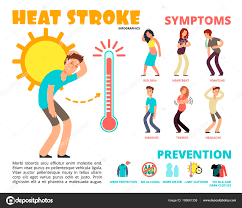Sun Stroke
July 15, 2019

It’s gonna be a scorcher!
Summer is here, and with it, those hot dog days of July. So, keep safe, and keep cool!
Healthy body temperature is regulated in a narrow range. The body’s main mechanism to regulate heat in a hot environment is by sweating: as the sweat evaporates, the body cools. However, when the relative humidity is over 75 percent, sweating alone can no longer keep the body cool. Fans can help dissipate heat through conduction and convection, but they cannot efficiently transfer heat away from the body when the environmental temperature exceeds skin temperature. (That’s why a fan does no good over 98 degrees!)
Heat related illness can range from a mild heat rash or sunburn to a fatal heat stroke. Let’s start with the more severe illness, heat stroke.
Heat Stroke, also called severe non-exertional hyperthermia, has a high mortality rate. It can cause respiratory failure, heart failure, kidney failure, shock, seizures , liver failure, swelling of the brain and internal bleeding.
WHAT TO LOOK FOR
- High body temperature (103°F or higher)
- Hot, red, dry, or damp skin
- Fast, strong pulse
- Headache
- Dizziness
- Nausea
- Confusion
- Losing consciousness (passing out)
WHAT TO DO
- Call 911 right away-heat stroke is a medical emergency, patients often need intensive are treatment with IVs and mechanical ventilation
- Move the person to a cooler place
- Help lower the person’s temperature with cool cloths or a cool bath (but not ice cold!)
- Do notgive the person anything to drink
Heat Exhaustion
WHAT TO LOOK FOR
- Heavy sweating
- Cold, pale, and clammy skin
- Fast, weak pulse
- Nausea or vomiting
- Muscle cramps
- Tiredness or weakness
- Dizziness
- Headache
- Fainting (passing out)
WHAT TO DO
- Move to a cool place
- Loosen your clothes
- Put cool, wet cloths on your body or take a cool bath
- Sip water
Get medical help right away if:
- You are throwing up
- Your symptoms get worse
- Your symptoms last longer than 1 hour
Heat Cramps
WHAT TO LOOK FOR
- Heavy sweating during intense exercise
- Muscle pain or spasms
WHAT TO DO
- Stop physical activity and move to a cool place
- Drink water or a sports drink
- Wait for cramps to go away before you do any more physical activity
Get medical help right away if:
- Cramps last longer than 1 hour
- You’re on a low-sodium diet
- You have heart problems
Sunburn
WHAT TO LOOK FOR
- Painful, red, and warm skin
- Blisters on the skin
WHAT TO DO
- Stay out of the sun until your sunburn heals
- Put cool cloths on sunburned areas or take a cool bath
- Put moisturizing lotion on sunburned areas
- Do not break blisters
Heat Rash
WHAT TO LOOK FOR
- Red clusters of small blisters that look like pimples on the skin (usually on the neck, chest, groin, or in elbow creases)
WHAT TO DO
- Stay in a cool, dry place
- Keep the rash dry
- Use powder (like baby powder) to soothe the rash
https://www.cdc.gov/disasters/extremeheat/pdf/Heat_Related_Illness.pdf